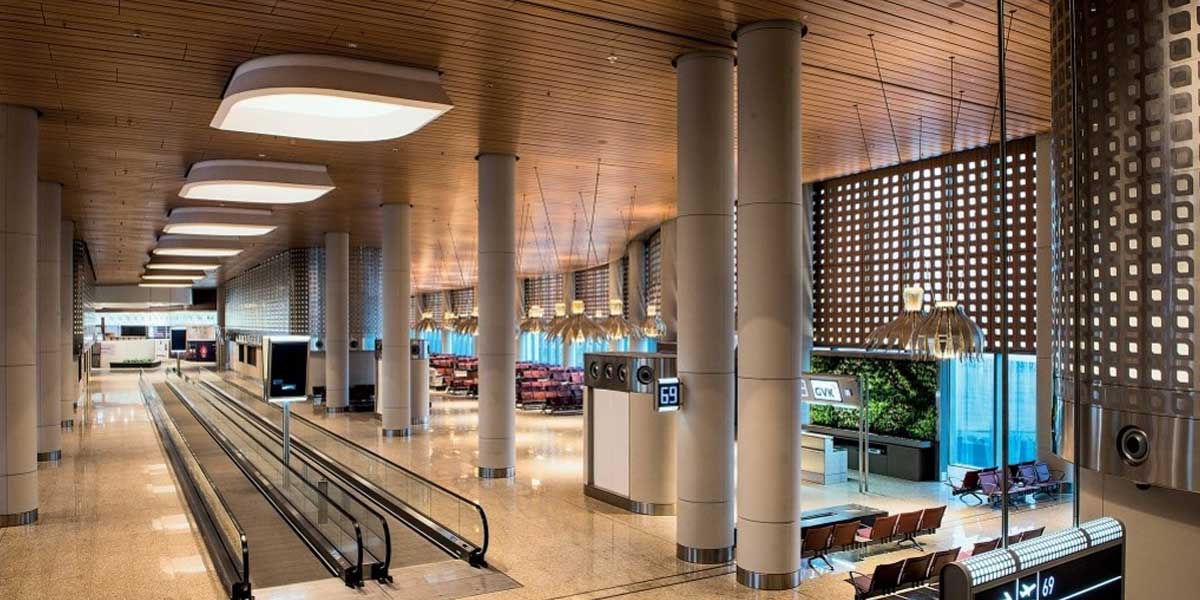The year 2020 was a washout for speciality contracting, spanning mechanical, electrical,
plumbing (MEP), heating, ventilation and air-conditioning (HVAC), facades, fit-outs, glass and
roof work. But now that business is resuming, where are the opportunities?
In the real-estate sector, “mid-segment realty is seeing better movement,” says Amitabha Sur,
Director, Operations, Aircon India Incorporated. “Owing to a shift in buyer preferences, mid-
segment projects are also providing better facilities to end-users, giving opportunities to HVAC
contractors.”
“Mid-segment [the Rs 40-80 lakh band] residential realty has picked up but buyers are interested
in ready properties,” says Amit Mehta, Director, MEPF Engineering, Head, Infrastructure
& Engineering, INI Design Studio. “Prior to the pandemic, demand also existed for under-
construction properties. Commercial property rentals are down 40-50 per cent; hence, investors
are somewhat reluctant to buy.”
In the infra space, Sur sees sizeable movement and good opportunities in the health and medical
segment.
“Awareness of the impact of the quality of MEP services on health and the provisioning of
services has increased in the healthcare sector and industrial units; such organisations are more
conscious of getting it right to operate safely,” opines Mohiyuddin Shariff, Managing Partner,
Mepsys Engineering Services. “We’re seeing inquiries from hospitals and industries for a redo
or upgrade of their MEP installations to make them more safe and dependable, apart from the
regular real-estate clientele.” He believes this interest might be triggered by the need of these
organisations to meet mandatory provisions.
“Government-funded infrastructure projects, like the Navi Mumbai Airport, Mumbai Trans-
Harbour Link, IIT, IIM and the Delhi-Mumbai Industrial Corridor, are the biggest prospect for
speciality contractors now,” says Deepaq Parrkar, Director, Ace Façade.
“Airports, metro rails and hospitals present the biggest opportunities for interior fit-outs, MEP,
HVAC, façade, glass and roofing speciality contractors,” adds Rohit Arya, Country Head,
Lindner India Construction.
For his part, Maniesh Thakur, Director, Atom Group of Companies, sees the most
opportunities in infrastructure, the establishment of new industries, and design and consultancy.
“The only inquiries we are seeing are from infra projects such as the Chennai metro,” says
Vasanth Kumar T, CEO, 4C Building Envelopes & Heights. “It’s as though residential
property has died! We used to get five to six inquiries a week; now, we get one to two a month.”
Broad-based is better
As most recent investments are happening through the government sector, large speciality
contractors are better placed to clinch those contracts because of their broad experience,
credentials and financial strengths, says Sur.
In the façade sector, Parrkar believes broad-based speciality contractors have better prospects for
good infrastructure and manpower and the ability to take on projects from design till execution.
“Only a few façade contractors in India can deliver projects as per the client’s project
specifications spanning their choice of code (IS, BS, ASTM), quality, fabrication and installation
standards, equipment specifications, material specifications, façade testing methods, etc.,” he
says.
Gaurav Kumar, Project Lead, MG Cooling Solutions, sees contractors widening their horizon
to take on bigger projects to increase their turnover, and then subletting parts as needed. For
instance, HVAC contractors are additionally taking on electrical work. He also sees scope for
super-speciality contractors, as contractors engaged in niche areas such as fire and safety may
not have core construction skills.
Arya agrees that speciality contractors are becoming more broad-based to tap bigger contracts,
taking on additional duties such as design (BIM modelling) and structural calculations and, in
some cases, also offering design and build services.
Another reason that makes the going brighter for players with wider expertise is the growing
need of clients to work with a single provider, an outcome of the pandemic, according to Tushar
Mittal, Founder & MD, Studiokon Ventures. “Owing to the pandemic, many companies do
not want to deal with multiple touchpoints and are opting for design and build contracts, which
suits us very well because we do everything.”
Customers are preferring contractors who can do everything from MEP to HVAC and more,
opines Thakur, who also says it has become common for contractors to take on wide contracts
and execute them independently if possible, or else with the support of multidomain companies.
Shariff has experienced the preference of working with a multidiscipline, single-provider among
hospitals. He believes this is being driven by government contract directives and the private
sector may also gradually catch up. “Hospitals want one vendor who can understand the entire
project intent or a single representative of a group of vendors who can understand the
deliverables of the project.”
Obviously, the vendor in question must be big and skilled enough to handle the intricacies of the
contractual arrangements across all specialised areas. “This person must be capable of sitting
across a table and shedding light on last-mile connectivity solutions for different aspects of the
infrastructure backbone—be it electrical, mechanical, PHE or HVAC,” underlines Shariff.
In the façade segment, too, most civil contractors like L&T and Shapoorji Pallonji take on design
build contracts that give their clients a single point of contact for convenience, points out
Parrkar. “A few corporate projects like the Reliance Twin Towers in Thane Belapur and the JIO
Garden in the Bandra-Kurla Complex have been awarded directly by the client. Because of this,
façade contractors rarely get to work directly with clients, despite preferring to do so.”
Basis of work
When the employer/builder has a detail design consultant team, MEP and HVAC works are
mostly awarded on the item rate/BOQ contract basis, observes contract specialist Sudeep
Dutta. “When a design team is absent, contracts tend to be awarded on a lumpsum basis and
require the bidder to additionally design. Facade works are generally contracted on a lumpsum
basis because these are associated with fewer unknown factors and confirmed specifications.”
Generally, item rate/BOQ contracts are better for contractors because they get paid for the actual
quantities/services/works, including extras not mentioned in the tender, and are less risky for
both parties, he adds. “In lumpsum contracts, the risk of quantity variation is transferred to the
bidder for a substantial cost, and the chances of getting paid for extra items are remote and
cumbersome.” Unit rate contracts are the most popular contract in the building segment, opines Sur, while in the
industrial segment, the popular format is design build contracts with lumpsum contract pricing.
“A unit rate contract is safer from the contractor’s perspective but if the initial assessment of the
project is incorrect, the investor often doesn’t get the right reflection of the final cost, leading to
a cost overrun,” he shares. “In design build contracts, ‘good for construction’ drawings and
accurate bill of materials are critical, but these largely depend on the input data and drawings
received by the contractor.” Sur proposes basing contract selection on relevance.
Meanwhile, Arya believes EPC contract formats are most popular nowadays as clients prefer to
pass the complete responsibility on to the main contractor. In terms of the payment mode, rate-
based contracts are the most popular.
Interestingly, contractors attest to preferring design and build opportunities.
“Our projects tend to be turnkey EPC contracts,” says Shariff. “We are very happy to design but
clients feel that asking a single party to design and execute could create a conflict of interest.
They want to keep design and execution separate.” However, Vasanth says, “We prefer turnkey
design and build contracts over EPC projects because those are more remunerative and give us
the freedom to work creatively.”
“Design and build tends to become an opportunity where we are asked to take on the certification
of the system,” continues Shariff. “Then, the client is sure that no external verification of the
design is needed.”
Contract standardisation
Model construction contracts published by the Federation Internationale des Ingenieurs-Conseils
(FIDIC, International Federation of Consulting Engineers) are some of the most widely used
formats globally. But India hasn’t ‘officially’ adopted any of these.
In India, employers normally adopt a customised, self-serving version of the FIDIC construction
contract, according to Jithin Palakkal, Partner, Praxis Legal. “Every FIDIC contract lays
down general conditions that can be superseded by Conditions of Particular Application (COPA)
to cater to specific requirements of the employer and/or the contractor. Usually, these non-
negotiable COPA provisions are what serve the interests of employers and could go against the
contractor. So, a FIDIC contract untouched by COPA would definitely be the choicest standard
contract.”
In the private sector, “many leading Indian brands opt for one-sided contracts while
multinational corporations tend to have more balanced contracts that take cognisance of
contractors’ rights,” says Mittal.
Government authorities engaged in construction, such as the National Highway Authority of
India, Public Works Department and National Building Construction Corporation, use their own
standard formats, points out Ankit Sahoo, Associate, Lex Counsel Law Offices.
In government contracts, some standardisation exists, agrees Palakkal. But, those contracts are
far from ideal. “Any contract that is well balanced and allocates risk equally to both parties is
ideal,” he explains. “In practice, departments like the Railways have their own tough, non-
negotiable general conditions of contract. For instance, some of the stringent provisions of the
Railways’ contract include entitlement to withhold payments from other railway contracts being
executed by the contractor anywhere in India [of such amount as unilaterally determined by the
Railways], merely by alleging default on the part of the contractor in executing work under any
other contract and non-liability to pay interest on any delayed payments even if the dispute is
referred to arbitration. The payments are made 20 years later, with no compensation for delay
caused by the Railways.” In his view, this unattractive contract format is why numerous floated
tenders by the Railways don’t attract established players.
“Non-standard contracts are why India sees an abnormally high number of contractual disputes,”
observes Dutta. “With standard contract formats, the chances of dispute are lower as the events
causing dispute are listed and provisioned for.”
“As long as employers continue to focus on escaping legal liability with self-serving non-
negotiable provisions in contracts, their books will reflect the savings and fruit of escaped
liability, but the quality of work will continue to deteriorate,” adds Palakkal.
Industry feedback
Industry members express their doubt about contract standardisation ever happening.
“Standardising the type of contracts may not be beneficial as every project has its own
dynamics,” says Sur. “But there is a definite need to standardise the terms of execution of each
type of contract.”
Mittal doesn’t see any scope to standardise contracts because companies tend to have their own
contract format preferences.
Contracts vary from company to company and supplier to supplier, shares Kumar. “There are no
standard formats; the format and terms completely depend on mutual discussions that cover
delivery time, payment and warranty terms, and working on credit. Contracts that provide for
payment in advance or before the dispatch of the material work in the favour of the contractors.”
“There are no standard contracts,” avers Thakur. “A contract is favourable only when you get a
good price.”
In the developer market, contracts are better defined and managed as the owners or their
representatives can manage multiple contracts, according to Mehta. “However, there is a lot of
scope for improvement in both the government and institutional sectors where the trend is to give
out design and project management contracts to a project management consultant, who designs
the project and tenders it out to turnkey contractors, who then manage the principle civil work
and speciality subcontractors who come onboard for MEP, HVAC, facade, STP works, etc.
Sometimes, an EPC or turnkey contractor is directly hired, who then brings onboard
subcontractors and manages them.”
According to him, the challenge is that larger contractors bring onboard small players without
the requisite technical knowhow to cut corners and this is why built infrastructure lacks
functionality or does not perform as desired. The ideal situation would be to require a consortium
of contractors (civil plus speciality) to bid for a tender and be evaluated jointly, as is being done
in developed realty markets like the UAE, and thereafter require those players to execute the
project.
Contractor protection
In recent times, an example of a balanced contract wherein an attempt has been made to reserve
the rights of the contractor would be the one adopted by the NHAI, says Palakkal. “However, in
practice, we have seen instances of no payments being made towards compensation or interest
despite the clear failure of the NHAI.”
So what is a contractor to do in a scenario where—to quote Palakkal—“no contracts in the
private or public realm are 100 per cent contractor-friendly”?
As far as possible, “contractors should push to build in provisions to protect their rights and
interests such as limitation of liability, extent of indemnity obligations, third-party liabilities,
exposure on death or other destruction during implementation of the contract obligations, safety
compliance limitations, liquidated damages and extent in percentage to the contract payment,
clarity on milestone payment and its assessment, levy of interest on delayed payments,
suspension of performance of obligations on the occurrence of events like default in performance
of employer’s obligation, occurrence of a force majeure event, non-payment of dues for work-
performed, etc,” suggests Sahoo. “In our experience, a large number of construction contract
disputes relate to delays, which are often contributory, like delay in handover of site or approval
of design and certification of completed works. Therefore, special attention needs to be devoted
to drafting the relevant contractual provisions to eliminate, so far as possible, any possibility for
confusion or misinterpretation.”
However, considering that employers—including the Government—are extremely reluctant to
part with money even if a contractual obligation to do so exists, refusing to abide by contractual
provisions or manufacturing a dispute presuming that a contractor would waive or forfeit their
entitlement to avoid time-consuming and expensive litigation, Palakkal recommends that
contractors maintain evidence of employer breaches, such as timely written letters describing
how the employer is responsible for the delay, hence substantiating their right accruing under the
contract, and documents that prove the quantum of damages.
And you thought speciality contractors had a special deal?
Contractor woes
Labour plays a huge role in the construction sector, both local and migrant, albeit the latter plays
a bigger role and hence the scarcity is felt more acutely. The unavailability of labour has
definitely hampered the progress of projects, opines Amitabha Sur, Director, Operations,
Aircon India Incorporated. Contractors have managed by deploying city-based labour. “We
were never fully dependent on migrants so we found the labour situation manageable,” says
Vasanth Kumar T, CEO, 4C Building Envelopes & Heights. “But city-based labour is not as
hardworking or productive as migrant labour, as migrants come with the sole purpose of earning
money.”
The scarcity of labour has increased the cost of employment. “The cost of labour has moved up
by 20-25 per cent as most workers have yet to return, says Gaurav Kumar, Project Lead, MG
Cooling Solutions. “Migrant unskilled labour is in short supply and costs 10-15 per cent more
than the pre-COVID days,” adds Mohiyuddin Shariff, Managing Partner, Mepsys
Engineering Services. Migrant labour costs have increased by about 20 per cent, reckons
Vasanth. “Aside from the scarcity, labour has also become more expensive because of the higher
outlay on safety and care,” adds Maniesh Thakur, Director, Atom Group of Companies.
Cash flows had slowed even before the pandemic; now, the situation has given clients extra
reasons to further delay on payments, says Vasanth. In Shariff’s view, our current fiscal
challenges are because payment terms are being renegotiated on newer formats, which increases
our input costs to our disadvantage. Project execution delays, new project rollout delays and
restricted cash flow are still concerns, emphasises Sur.
Apart from labour scarcities, cash flow is a big challenge, affirms Rohit Arya, Country Head,
Lindner India Construction, especially dealing with no price escalation clauses and huge price
escalation in raw material prices, especially steel.
Cash flows have come to a standstill in some cities like Surat and Mumbai; other cities are
partially affected but places like Ahmedabad and smaller towns in Gujarat have recovered well,
adds Amit Mehta, Director, MEPF Engineering, Head, Infrastructure & Engineering, INI
Design Studio.
Working smarter
When the going gets tough, the tough get going. Indian contractors have evolved to cope with the
pandemic, as they share:
Offsite working: “Earlier, we were doing a lot of joinery work onsite whereas now we
are doing 85 per cent work in the factory,” says Tushar Mittal, Founder & MD,
Studiokon Ventures. “When you work onsite, wastage tends to be more even though it
is reusable, but the cost of compliance is also higher.”
Multitasking: We have trained our workforce to multitask, whereas earlier one man was
doing one particular job; this has also helped optimise our costs, adds Mittal.
Incentive-based salaries: “We have made the salary of all employees incentive-based;
barring a small percentage of the pay, the rest is all variable,” shares Vasanth Kumar T,
CEO, Aluvations.
Expanded portfolio: MG Cooling Solutions has sought to evolve its technology
offerings to attract new clients and satisfy existing clients. “During the pandemic, we
expanded our centralised air-conditioning offering to include air and surface disinfection
through UV lamps for the safety of clients,” says Gaurav Kumar, Project Lead, MG
Cooling Solutions. “First, we observed the outcome of UVGI technology as an effective
measure to kill bacteria, fungi and viruses in the air flow, and then improvised.”
Extra spend on projects: Lindner Group is the only fit-out contractor that also
manufactures major building material products inhouse, like metal ceilings, partition
system, raised floor systems, facade, roofing systems, lighting system, wall cladding and
doors. During the pandemic, Lindner never held back production and design works, and
invested funds and additional man hours to complete the design and deliver materials for
the Bangalore International Airport Terminal 2 bespoke bamboo package on time.
- CHARU BAHRI




















